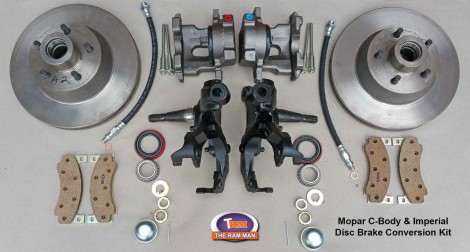I can give you some first-hand live experience....
Bought my 1969 Fury in February of 2023. Previous owner had someone install SSBC rotors, calipers, adapters, and adjustable rear brake valve. Also installed a LEEDS brake booster.
1) Car stops fine in a controlled stop. However, a panic stop...No such luck. The pedal is firm, the car just plain does not stop like I think it should. Does not instill confidence in an uncontrolled situation.
NOTE: I have been working on cars for 40 years. Been an old-car guy most of those years. I am NOT comparing this car to my daily drivers (both
newerand 4 wheel disc <2002 F 150, and 2007 Crown Victoria>). My manual drum brake 1970 Dart stops significantly better than the Fury.
2) Pedal was 1 FOOT off of the floor with an auxilary return spring attached when I got it (shame on previous owners mechanic). Spoke with LEEDS, and they s sent me a shorter adapter rod. Pedal now seven inches off the floor.
3) The pedal also won't return all the way up unless I pull it up with my foot after EVERY brake application. Contacted LEEDS again. They said I need a new brake booster. I purchased their (Chinesium) booster. 200 dollars later, same problem. 200 bucks gone.
4) July 2023. I am in the right place at the right time, and score a complete disc setup off of a 1972 New Yorker. I snag all of it; including the brake pedal
assembly.
5) March 2024...I took the entire front end apart. New bushings, ball joints, etc...I removed the SSBC system, and LEEDS booster. Install all new suspension,
and install the stock 1972 system off of the New Yorker.
NOTE: This includes a rebuilt (booster Dewey) brake booster, rebuilt calipers, and new rotors, bearings and the 1972 metering/proportioning/delay valve.
6) The mass difference alone when comparing the SSBC rotors to the stock Chrysler rotors is significant, in addition to the increased stopping surface area.
Unconfirmed rumor: The calipers and rotors, based on size and mass, were originally designed for a 1st generation Mustang. I cannot confirm nor deny
that rumor. Significant difference in master cylinder too. However, to be fair, I do not know the master cylinder bore sizes.
7) I took the car down the street yesterday. I didn't go far, as I need an alignment. However, the car stops significantly better with the stock
Mopar system from the 1972 New Yorker than the aftermarket system.
In conclusion: I am very glad that I eliminated the aftermarket disc system. Had I not acquired the Mopar disc system, this year, I would have sourced drum brakes and put the car back to drums. I do not recommend these aftermarket systems, though others may differ.


















